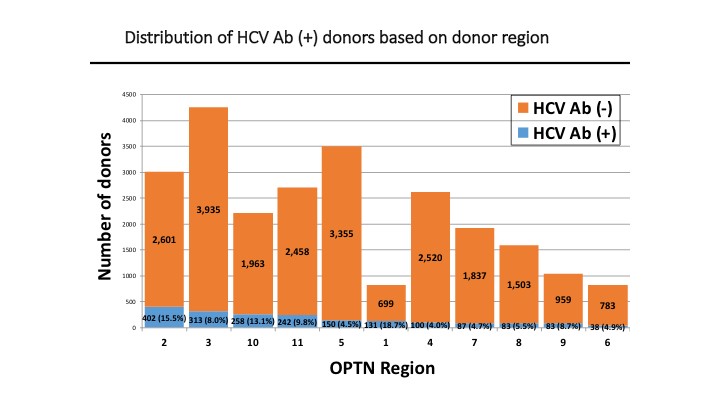HCV-Positive Donors Are Healthier and Inequitably Utilized in the United States
B. L. Da, T. Kushner, G. Kakked, J. Crismale, G. Ezaz, T. Schiano, B. Saberi
Liver Disease, Icahn School of Medicine at Mount Sinai, New York, NY
Meeting: 2020 American Transplant Congress
Abstract number: 45
Keywords: Donors, unrelated, Hepatitis C, Liver grafts, Liver transplantation
Session Information
Session Name: Liver: MELD, Allocation and Donor Issues (DCD/ECD) I
Session Type: Oral Abstract Session
Date: Saturday, May 30, 2020
Session Time: 3:15pm-4:45pm
 Presentation Time: 4:15pm-4:27pm
Presentation Time: 4:15pm-4:27pm
Location: Virtual
*Purpose: Increased utilization of HCV-positive (HCV+) liver allografts has been endorsed as a solution to the national organ shortage. Due to the opioid epidemic, there has been an increase in availability of HCV+ organs. We evaluated characteristics of HCV+ donors and UNOS regional differences in the utilization of HCV+ liver allografts.
*Methods: The SRTR (Scientific Registry of Transplant Recipients) database was queried for all HCV antibody (HCV Ab) and HCV nucleic acid amplification testing (HCV NAT) positive and negative donors from June 2015 to December 2018. Donor data including demographics, clinical and laboratory, allograft characteristics, as well as regions of transplant were collected and compared between HCV+ and HCV- donors.
*Results: A total of 24,500 donors were utilized for deceased donor liver transplant (DDLT) of whom 1,887 (7.7%) were HCVAb+ and 1,280 (5.2%) were HCVNAT+. 64.4% of HCVAb+ donors were HCVNAT+. HCVAb+ donors were significantly younger, median age 35 (IQR 29, 46) vs. 40 (IQR 27, 54) years (p<0.001), more likely to be of white ethnicity, 81.0% vs. 63.2% (p<0.001), and had fewer comorbidities such as diabetes and hypertension compared to HCVAb- donors. HCVAb+ donors was more often classified as a high-risk donor, 79.3% vs. 23.6% (p<0.001). HCVAb+ liver allografts had less micro and macro-steatosis compared to HCVAb- liver-allografts. Compared to HCVAb+ donors, HCVNAT+ donors may be even younger, with less comorbidities, more often classified as a high-risk donor (83.5%). Regions 2, 3, 10, and 11 had the highest absolute HCVAb+ donor utilization (n=1,215) accounting for 64.4% of all HCVAb+ donors. In regards to percentage of total donor pool, region 1 had the highest percentage of HCVAb+ donor (18.7%) relative to HCVAb- followed by region 2, 10, and 11 (Figure 1). Philadelphia, PA (region 2, 196 donors), Waltham, MA (region 1, 131 donors), Nashville, TN (region 11, 86 donors), and Baltimore, MD (region 2, 70 donors) had the highest HCVAb+ donor utilization. Similar findings were found with HCVNAT+ donor analysis.
*Conclusions: HCV+ donors are younger and healthier than HCV- donors. Significant variations in the utilization of HCV+ donors exist across the 11 UNOS regions which is not entirely explained by organ demand and may be explained by higher availability of HCV+ organs where opioid epidemic is most pronounced and/or center experience with utilizing HCV organs. Initiatives to increase the use of HCV+ donors in particularly in regions of high organ demand should be implemented.
To cite this abstract in AMA style:
Da BL, Kushner T, Kakked G, Crismale J, Ezaz G, Schiano T, Saberi B. HCV-Positive Donors Are Healthier and Inequitably Utilized in the United States [abstract]. Am J Transplant. 2020; 20 (suppl 3). https://atcmeetingabstracts.com/abstract/hcv-positive-donors-are-healthier-and-inequitably-utilized-in-the-united-states/. Accessed November 5, 2025.« Back to 2020 American Transplant Congress

